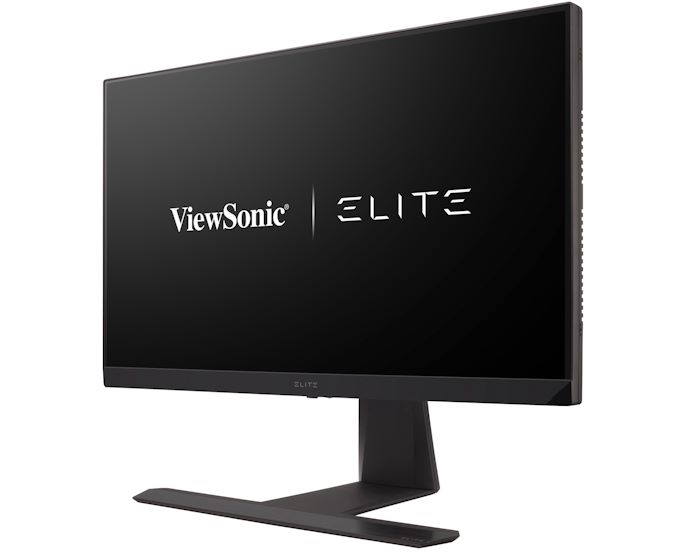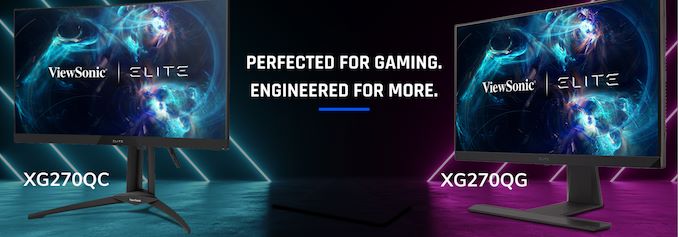Supersonic: ViewSonic’s Elite XG270 240 Hz IPS Monitor w/ VRR & HDR
by Anton Shilov on September 27, 2019 3:00 PM EST
Aiming at demanding hardcore and esports gamers, ViewSonic this week introduced its new gaming display that uses a ‘fast IPS’ panel with a 240 Hz maximum refresh rate. The Elite XG270 is among the first monitors in the industry to offer a unique combination of rich colors, wide viewing angles, HDR10, and a variable refresh rate of up to 240 Hz.
The ViewSonic Elite XG270 is based a 27-inch panel featuring a 1920×1080 resolution along with all the features that the ‘fast IPS’ technology is known for today, including 400 nits brightness, a 1000:1 contrast ratio, 178°/178° viewing angles, a 1 ms GtG response time. The monitor can display 16.7 million of colors and reproduce 99% of the sRGB color space, which is in line with other LCDs using the same panel.
For hardcore gamers, the key feature of the Elite XG270 is its variable refresh rate of up to 240 Hz. In an official document, the monitor supports VESA’s Adaptive Sync technology, yet in its press release ViewSonic claims AMD’s FreeSync support, which may indicate that the company has submitted the monitor to AMD for certification and fully expects it to pass it as the vast majority of Adaptive Sync-enabled displays can do it. Considering the fact that the monitor will be available only several weeks from now, the company has time.
The monitor also fully supports HDR10, so console gamers with HDR10-supporting titles will probably be pleased, even though its level of luminance is considered rather low for HDR, so the actual HDR user experience is something that remains to be seen.
As added bonuses, the Elite XG270 display comes with 3 W stereo speakers (and probably a headphone output too), an Elite display controller, a mouse bungee, and a headphone hook. Unfortunately, right now ViewSonic does not disclose what kind of display inputs the monitor has, though it is reasonable to expect at least a DisplayPort and an HDMI.
| The ViewSonic Elite IPS LCD with a 240 Hz Refresh Rate | ||
| Elite XG270 | ||
| Panel | 27-inch class IPS | |
| Native Resolution | 1920 × 1080 | |
| Maximum Refresh Rate | 240 Hz | |
| Dynamic Refresh | Technology | AMD FreeSync VESA Adaptive Sync |
| Range | ? | |
| Brightness | 400 cd/m² | |
| Contrast | 1000:1 | |
| Viewing Angles | 178°/178° horizontal/vertical | |
| Response Time | 1 ms GtG | |
| Pixel Pitch | ~0.27675 mm² | |
| Pixel Density | ~82 PPI | |
| Color Gamut Support | 99% sRGB | |
| Inputs | ?×DP 1.2 ?×HDMI 2.0 |
|
| Audio | 3 W speakers headphone out |
|
| Stand | ? | |
| Warranty | ? years | |
| MSRP | $429.99 | |
ViewSonic’s Elite XG270 gaming display will be available in November at an estimated retail price of around $429.99, which is considerably below MSRP of Dell’s Alienware 27 (AW2720HF) that features similar key characteristics (27-inch, fast IPS, 240 Hz) yet sells for $599.99.
Related Reading:
- Fast & Furious: The Alienware 27 (AW2720HF) 240 Hz IPS Monitor with FreeSync
- Need for Speed: The LG UltraGear (27GN750) 240 Hz IPS Monitor with G-Sync
- HP's Omen X 27: A 240Hz QHD Monitor with FreeSync 2 HDR
- Samsung’s CRG5 Curved 27-Inch 240 Hz G-Sync Monitor Now Available for $370
- Acer Launches Predator XN253QX Monitor with 240 Hz & 0.4 ms G2G Response Time
- AOC’s Agon Monitors with 0.5ms Response Time & 240 Hz Refresh Now Available
Source: ViewSonic
Note: Image is for illustrative purposes only











35 Comments
View All Comments
Socius - Friday, September 27, 2019 - link
Sadly, the statement about 1440p is true. 27" 1440p at 144-200Hz is currently the best option. I bought the Asus 4K HDR 144Hz monitor, expecting the "RTX" line of cards to provide a 75% performance increase over the last generation of cards, as Nvidia had previously done. But as a result, I can no longer play any of my FPS games comfortably. I have to use lower internal resolution scale and etc...i wish I could go back to my 165Hz 1440p monitor and put the $2000 price of the new monitor back in my pocket. Lol.Nvidia has really effed us. Or arguably...AMD has effed us, by not being competitive enough to force Nvidia to put out better cards.
Opencg - Saturday, September 28, 2019 - link
I agree man. Nvidia chose to sacrifice performance per dollar for extra silicon supporting ray tracing and ai. In retrospect and actually even pre launch to anyone who knew the demand of actual good raytracing it was a bad idea. The super cards have regained some value. And this is directly related to amd forcing them to.imaheadcase - Saturday, September 28, 2019 - link
This monitor isn't 1440p..Guspaz - Saturday, September 28, 2019 - link
nVidia recently added integer scaling to their newest cards, so you could try treating that display as 1080p for gaming purposes. Though I’m not sure that would look better than 1440p using interpolated scaling.imaheadcase - Saturday, September 28, 2019 - link
But this isn't 1440p...lol No one is saying 4k for everything, I play PUBG, fast paced FPS on 35inch 120Hz monitor and have zero issue. I've also played apex legends for a little bit on my 4k just fine.Socius - Friday, September 27, 2019 - link
The same people who bought into $1200 RTX cards that offer 40-60fps at 1080p with ray tracing. Then again...this is too much refresh rate at 1080p for the latest generation Nvidia cards. Woah is me. 1st world problems. lol.Tams80 - Saturday, September 28, 2019 - link
As well as people who want lower resolutions so that they can run games smoother and at higher framerates, 4k displays of the same quality in other aspects are considerably more expensive.imaheadcase - Saturday, September 28, 2019 - link
It doesn't even have to be 4k, just so many better monitors than this.StevoLincolnite - Monday, September 30, 2019 - link
At-least make it 1440P so you don't notice the screen door effect as much.peevee - Monday, September 30, 2019 - link
The right solution to screen door effect is the high pixel-to-interpixel space ratio, not useless resolution which robs performance and power.